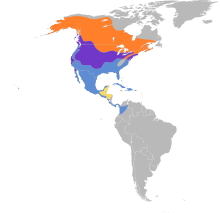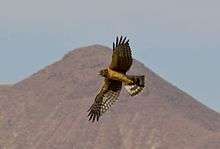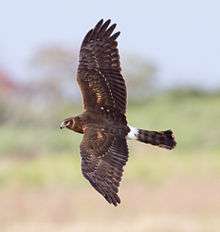Northern harrier
The northern harrier (Circus hudsonius) is a bird of prey.
| Northern harrier | |
|---|---|
_Harrier.jpg) | |
| Adult female | |
| Scientific classification | |
| Kingdom: | Animalia |
| Phylum: | Chordata |
| Class: | Aves |
| Order: | Accipitriformes |
| Family: | Accipitridae |
| Genus: | Circus |
| Species: | C. hudsonius |
| Binomial name | |
| Circus hudsonius (Linnaeus, 1766) | |
 | |
| Synonyms | |
|
Circus cyaneus hudsonius | |
It breeds throughout the northern parts of the northern hemisphere in Canada and the northernmost USA. While many taxonomic authorities split the northern harrier and the hen harrier into distinct species, others consider them conspecific.[2]
It migrates to more southerly areas in winter with breeding birds in more northerly areas moving to the southernmost USA, Mexico, and Central America. In milder regions in the southern US, they may be present all year, but the higher ground is largely deserted in winter.
Description


.jpg)
The northern harrier is 41–52 cm (16–20 in)[3] long with a 97–122 cm (38–48 in) wingspan. It resembles other harriers in having distinct male and female plumages. The sexes also differ in weight, with males weighing 290 to 400 g (10 to 14 oz), with an average of 350 g (12 oz), and females weighing 390 to 750 g (14 to 26 oz), with an average of 530 g (19 oz).[3][4] Among standard measurements, the wing chord is 32.8 to 40.6 cm (12.9 to 16.0 in), the tail is 19.3 to 25.8 cm (7.6 to 10.2 in) and the tarsus is 7.1 to 8.9 cm (2.8 to 3.5 in).[4] It is relatively long winged and long tailed, having the longest wing and tail relative to its body size of any raptor occurring in North America.[4]
The northern harrier has been split from the hen harrier by some taxonomists based on genetic analysis.[5] It breeds in North America and its closest relative is the Cinereous Harrier (C. cinereus). The male's plumage is darker grey than that of the hen harrier and the female is also darker and more rufous.[3] The adult male is sometimes nicknamed the "Grey Ghost", because of his striking plumage and spectral aura.[6][7]
The female gives a whistled piih-eh when receiving food from the male, and her alarm call is chit-it-it-it-it-et-it. The male calls chek-chek-chek, with a more bouncing chuk-uk-uk-uk during his display flight.
Behaviour
This medium-sized raptor breeds on moorland, bogs, prairies, farmland coastal prairies, marshes, grasslands, swamps and other assorted open areas.[8] A male will maintain a territory averaging 2.6 km2 (1.0 sq mi), though male territories have ranged from 1.7 to 150 km2 (0.66 to 57.92 sq mi).[9]
These are one of the few raptorial birds known to practice polygyny – one male mates with several females. Up to five females have been known to mate with one male in a season.[10] The nest is built on the ground or on a mound of dirt or vegetation. Nests are made of sticks and are lined inside with grass and leaves. Four to eight (exceptionally 2 to 10) whitish eggs are laid.[3][8] The eggs measure approximately 47 mm × 36 mm (1.9 in × 1.4 in).[11] The eggs are incubated mostly by the female for 31 to 32 days. When incubating eggs, the female sits on the nest while the male hunts and brings food to her and the chicks.[8] The male will help feed chicks after they hatch, but does not usually watch them for a greater period of time than around 5 minutes.[12] The male usually passes off food to the female, which she then feeds to the young, although later the female will capture food and simply drop into the nest for her nestlings to eat.[9] The chicks fledge at around 36 days old, though breeding maturity is not reached until 2 years in females and 3 years in males.
Hunting behavior
This is a typical harrier, which hunts on long wings held in a shallow V in its low flight during which the bird closely hugs the contours of the land below it. Northern or hen harriers hunt primarily small mammals, as do most harriers. Preferred prey species can include voles, cotton rats and ground squirrels. Up to 95% of the diet comprises small mammals.[13] However, birds are hunted with some regularity as well, especially by males. Preferred avian prey include passerines of open country (i.e. sparrows, larks, pipits), small shorebirds and the young of waterfowl and galliforms. Supplementing the diet occasionally are amphibians (especially frogs), reptiles and insects (especially orthopterans).[4] The species has been observed to hunt bats if these are available.[14] Larger prey, such as rabbits and adult ducks are taken sometimes and harriers have been known to subdue these by drowning them in water.[4] Harriers hunt by surprising prey while flying low to the ground in open areas, as they drift low over fields and moors.[3][8] The harriers circle an area several times listening and looking for prey.[8] Harriers use hearing regularly to find prey, as they have exceptionally good hearing for diurnal raptors, this being the function of their owl-like facial disc.[4] This harrier tends to be a very vocal bird while it glides over its hunting ground.
Mortality and competition
Little information is available on longevity in northern harriers. The longest lived known bird is 16 years and 5 months. However, adults rarely live more than 8 years. Early mortality mainly results from predation. Predators of eggs and nestlings include raccoons, skunks, badgers, foxes, crows and ravens, dogs and owls. Fledglings are also predated regularly, especially by great horned owls.[15] Both parents attack potential predators with alarm calls and striking with talons. Short-eared owls are natural competitors of this species that favor the same prey and habitat, as well as having a similarly broad distribution. Occasionally, both harriers and short-eared owls will harass each other until the victim drops its prey and it can be stolen, a practice known as kleptoparasitism. Most commonly, the harriers are the aggressors pirating prey from owls.[16]
Status
This species has a large range, and there is evidence of a population decline, but the species is not believed to approach the thresholds for the population decline criterion of the IUCN Red List (i.e., declining more than 30% in ten years or three generations). It is therefore classified as "least concern".[1]
Relationship with humans
Some Native American tribes believe that seeing a hawk on your wedding day is a sign of a long, happy marriage. Unlike many raptors, hen or northern harriers have historically been favorably regarded by farmers because they eat mice that damage crops and predators of quail eggs. Harriers are sometimes called "good hawks" because they pose no threat to poultry as some hawks do. Heavy pesticide use in the 1970s and 1980s caused a decline in harrier populations.[8]
References
- BirdLife International (2016). "Circus hudsonius". IUCN Red List of Threatened Species. 2016: e.T22727740A94959659. doi:10.2305/IUCN.UK.2016-3.RLTS.T22727740A94959659.en.
- Etherington, Graham J.; Mobley, Jason A. (2016-01-01). "Molecular phylogeny, morphology and life-history comparisons within Circus cyaneus reveal the presence of two distinct evolutionary lineages". Avian Research. 7: 17. doi:10.1186/s40657-016-0052-3. ISSN 2053-7166.
- del Hoyo, J.; Elliott, A.; Sargatal, J., eds. (1994). Handbook of the Birds of the World. Volume 2: New World Vultures to Guineafowl. Barcelona: Lynx Edicions. ISBN 978-84-87334-15-3.
- Ferguson-Lees, J.; Christie, D.A. (2001). Raptors of the World. London: Christopher Helm. ISBN 978-0-7136-8026-3.
- Oatley, G.; Simmons, R.E.; Fuchs, J. (2015). "A molecular phylogeny of the harriers (Circus, Accipitridae) indicate the role of long distance dispersal and migration in diversification". Molecular Phylogenetics and Evolution. 85: 150–160. doi:10.1016/j.ympev.2015.01.013. PMID 25701771.
- "If you've seen a Northern Harrier in flight, you know they are beautiful". Kawartha Lakes This Week. Lindsay, Ontario. June 11, 2018.
- Zimmer, David M. (October 20, 2014). "Historic Farm Holds Growing Appeal". The Record. Bergen County, New Jersey. p. L.6.
- "Northern Harrier (Circus cyaneus)". Wildlife Fact Sheets. Texas Parks and Wildlife Department. Retrieved 25 June 2012.
- Macwhirter, R.; Bildstein, K. (1996). Northern Harrier. The Birds of North America. pp. 1–25.
- "Northern Harrier". All About Birds. Cornell Lab of Ornithology. Retrieved 23 August 2012.
- Baicich, P.; Harrison, C. (1997). A Guide to the Nests, Eggs, and Nestlings of North American Birds. New York, NY: Academic Press. ISBN 978-0120728312.
- Weidensaul, Scott (1996). Raptors: the birds of prey. Lyons & Burford. ISBN 978-1-55821-275-6.
- Ryser, F. (1985). Birds of the Great Basin: A Natural History. Reno, Las Vegas: University of Nevada Press. ISBN 978-0874170801.
- Mikula, P.; Morelli, F.; Lučan, R. K.; Jones, D. N.; Tryjanowski, P. (2016). "Bats as prey of diurnal birds: a global perspective". Mammal Review. 46 (3): 160–174. doi:10.1111/mam.12060.
- Wheeler, B.; Clark, W. (1995). A Photographic Guide to North American Raptors. San Diego: Academic Press Inc. ISBN 978-0713667639.
- "Short-eared Owl – Asio flammeus". owlpages.com. 24 July 2013. Retrieved 1 December 2015.
External links
| Wikimedia Commons has media related to Circus hudsonius. |
- Northern Harrier Species Account – Cornell Lab of Ornithology
- Northern Harrier photo gallery at VIREO (Drexel University)
